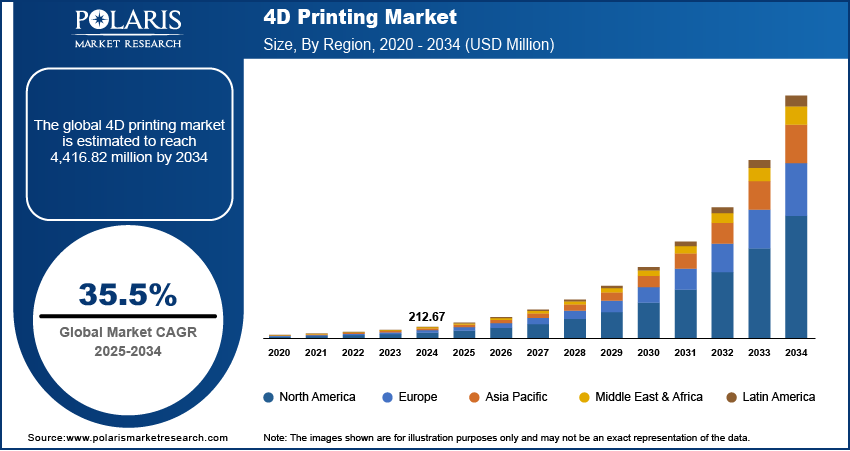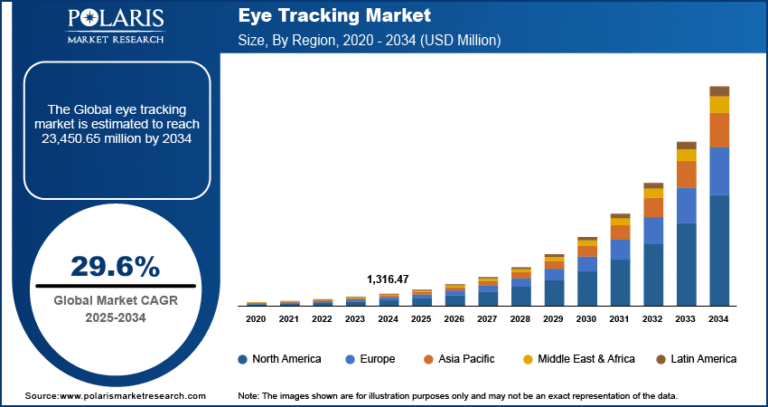4D Printing Market to Reach USD 4,416.82 Million by 2034 | CAGR: 35.5%

The global 4D printing market was valued at USD 212.67 million in 2024 and is expected to rise from USD 286.75 million in 2025 to USD 4,416.82 million by 2034, growing at a CAGR of 35.5% during the forecast period. A major factor driving this growth is the decline in processing and manufacturing costs, largely due to increased competition among key industry players.
4D Printing Market Key Trends & Insights:
- Advancements in smart, stimuli-responsive materials: Materials like shape-memory polymers, hydrogels, and programmable textiles are being developed to enable objects that self-transform in response to heat, light, moisture, or magnetic fields.
- Convergence with AI, IoT, and robotics: The integration of 4D printing with artificial intelligence, Internet of Things (IoT), and robotics is enhancing material behavior prediction, automated fabrication, and smart system deployment.
- Healthcare applications gaining momentum: The healthcare sector is increasingly adopting 4D printing for dynamic implants, smart drug-delivery systems, tissue scaffolds, and self-deploying medical devices, supporting personalized treatment approaches.
- Growth in aerospace, defense, and automotive sectors: These industries are utilizing 4D printing to produce lightweight, adaptive, and self-repairing components for applications such as deployable structures and advanced protective gear.
- Emphasis on sustainability and circular economy: 4D printing supports sustainable manufacturing by reducing material waste, enabling product longevity through self-healing features, and using recyclable or biodegradable materials.
Market Size & Forecast:
- Market size value in 2025 – USD 286.75 million
- Revenue forecast in 2034 – USD 4,416.82 million
- CAGR – 35.5% from 2025 – 2034
𝐆𝐞𝐭 𝐄𝐱𝐜𝐥𝐮𝐬𝐢𝐯𝐞 𝐒𝐚𝐦𝐩𝐥𝐞 𝐏𝐚𝐠𝐞𝐬 𝐨𝐟 𝐓𝐡𝐢𝐬 𝐑𝐞𝐩𝐨𝐫𝐭:
https://www.polarismarketresearch.com/industry-analysis/4d-printing-market/request-for-sample
4D Printing Market Overview:
The 4D printing market is witnessing significant momentum due to advancements in smart materials such as shape-memory polymers, hydrogels, and carbon fiber composites. These materials enable printed objects to change shape, properties, or functionality over time in response to external stimuli like heat, light, or moisture. Industries such as aerospace, automotive, healthcare, and defense are increasingly adopting 4D printing for its potential to create dynamic, self-adaptive components that enhance product performance, reduce maintenance, and enable lightweight, space-saving designs. The growing interest in customized and programmable materials is further driving market innovation and investment.
However, the market faces challenges including high equipment and material costs, limited awareness, and the need for advanced design tools and simulation capabilities. Regulatory hurdles, especially in medical and aerospace applications, also pose barriers to faster adoption. North America leads in market share due to strong R&D infrastructure, while Asia-Pacific is rapidly emerging as a key growth region supported by manufacturing expansion and government initiatives. Future opportunities lie in combining 4D printing with IoT, AI, and sustainable materials, paving the way for smarter, more responsive systems across various sectors.






![Rigid Plastic Packaging Market Analysis: Opportunities, Innovations, and Growth Potential Through [2025-2034]](https://beeswire.com/wp-content/uploads/2025/07/polaris-64-768x768.png)